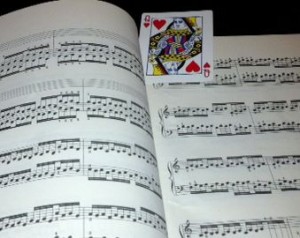Galumphing With Mr. Hanon
 Inspired by Steven Nachmanovich’s book, Freeplay, my friend and mentor, Dr. Lisa Zdechlik talks a lot about galumphing as we learn. (you know- the playing part of playing piano) We galumph when we take a tricky passage and practice it in rhythms, or improvise on it, or create an exercise from it and transpose it all over the map.
Inspired by Steven Nachmanovich’s book, Freeplay, my friend and mentor, Dr. Lisa Zdechlik talks a lot about galumphing as we learn. (you know- the playing part of playing piano) We galumph when we take a tricky passage and practice it in rhythms, or improvise on it, or create an exercise from it and transpose it all over the map.
This year, I have quite a few transfer students who have struggled with large leaps (10ths and more) in the LH while the RH is busy with intricate passagework. Waltzes, stride, and ragtime all require this skill. Advanced classical culprits include Liszt’s Waldesrauschen and Chopin’s Scherzo in C# Minor, where courage, accuracy, power, and speed are all crucial.
So, we started galumphing. First, we took the basic motion of the LH and played it randomly all over the keyboard. Accuracy was out of the equation and feel was everything. Next, we added the RH while still playing random intervals in the LH. We kept refining until the LH was again accurate.
Unfortunately, that process wasn’t always totally successful. So, we reversed it and improvised with the RH while playing the written LH. This was much harder for everyone. The task of keeping an improvised RH part galumphing along over the LH leaps resulted in the need to review the basic motion steps from the previous paragraph and a few meltdowns.
I needed to find a gateway to the skill. Something that was so basic that students could galumph with just the right amount of frustration.
(Yes, there is a right amount of frustration. Without it we don’t ask questions and grow. But, as they say, that’s another blog.)
Then, at 2:04 am, it came to me. Hanon. Here were the perfect repeated patterns under which the LH could galumph to its hearts content. We galumphed randomly using two half notes, then two quarter notes, and finally two 8ths per measure. We used octaves, then 10ths, and increased the intervals from there.
We started with the 5th finger and went upward. We started with the thumb and went downward. We kept the thumb note the same and changed the lower note and then reversed things, keeping the bass note and changing the upper one.
A great thing started to happen. Students began to create their own patterns and galumph with them. Some of them even reversed the hands. Quite a few of them found delight in getting back at Mr. Hanon. And, because they relaxed into playing with the skill their pieces got better too.
Have you galumphed today?



Totally great article! Thank you